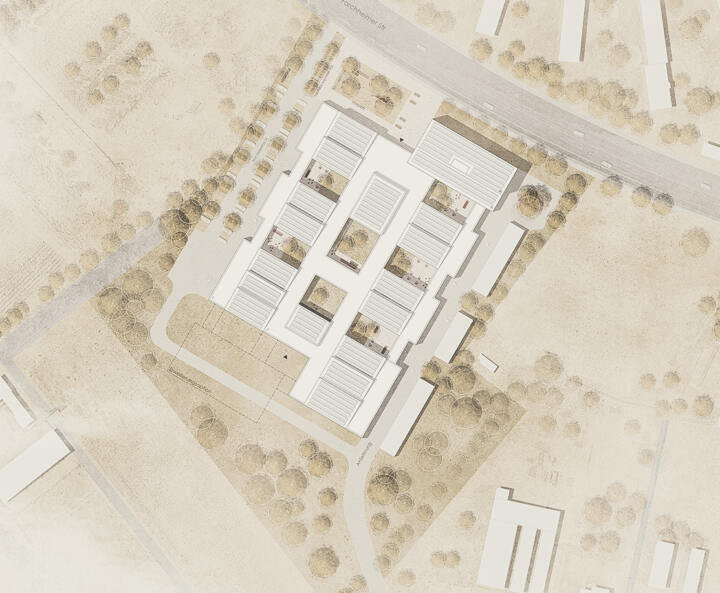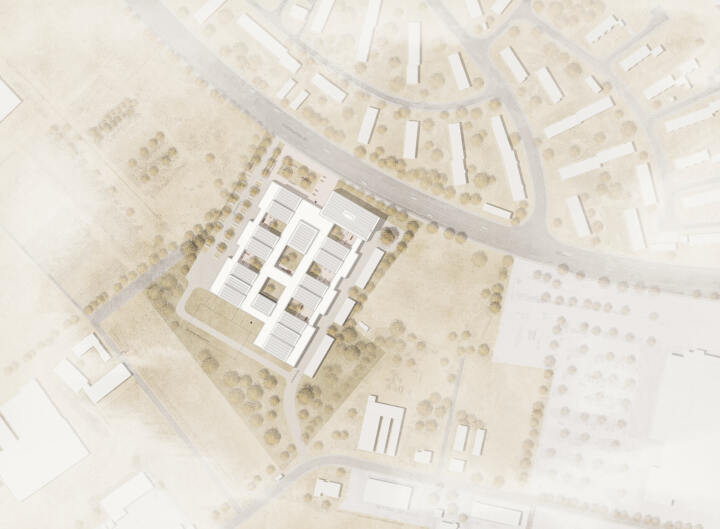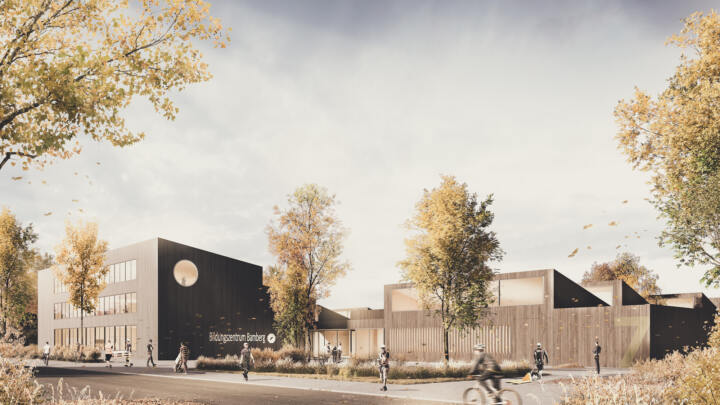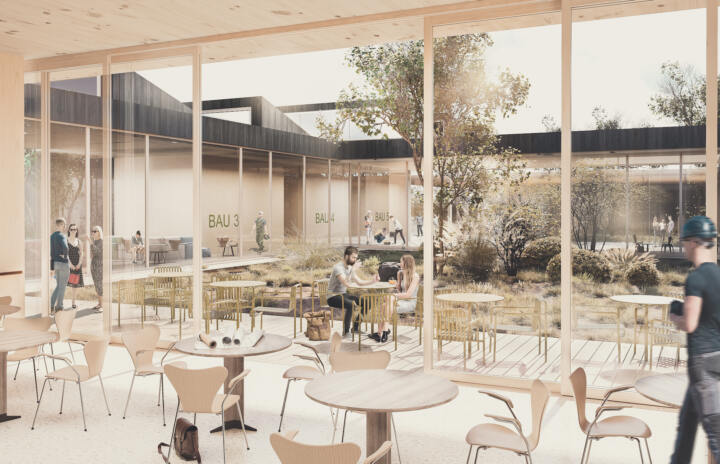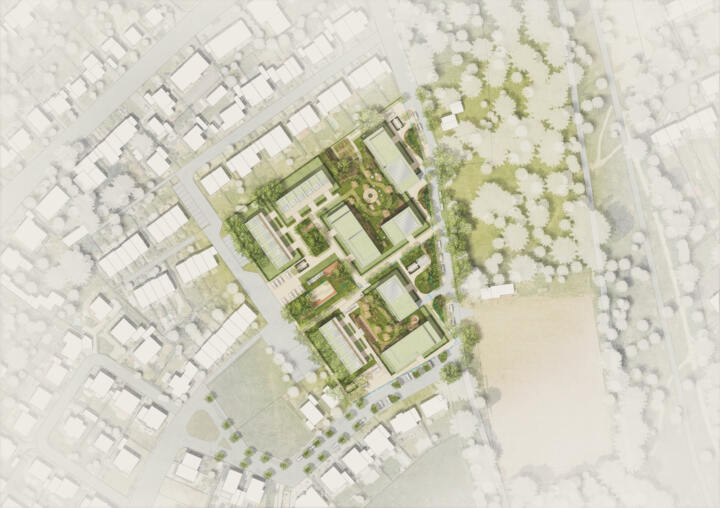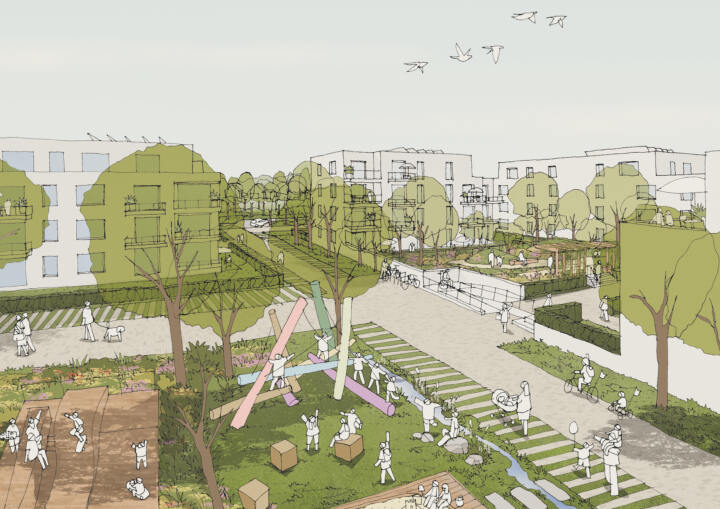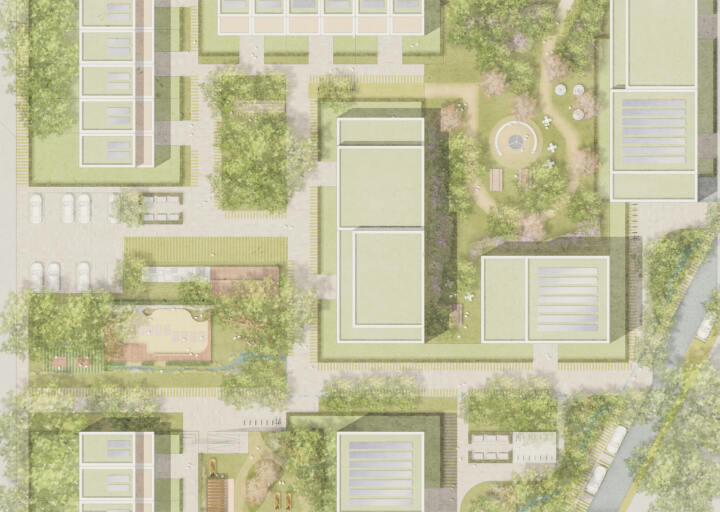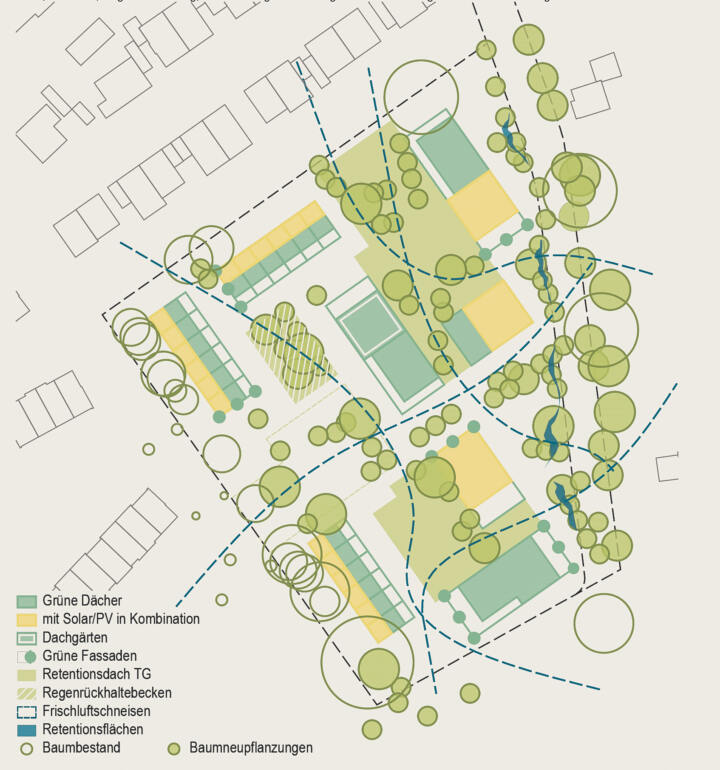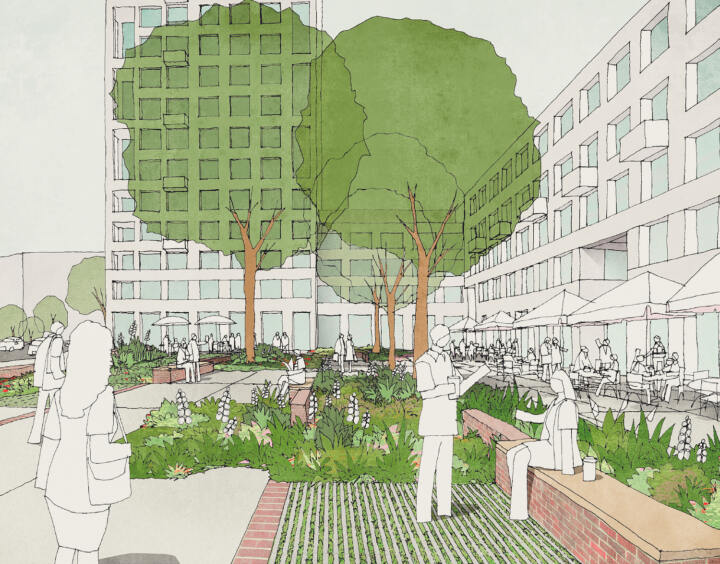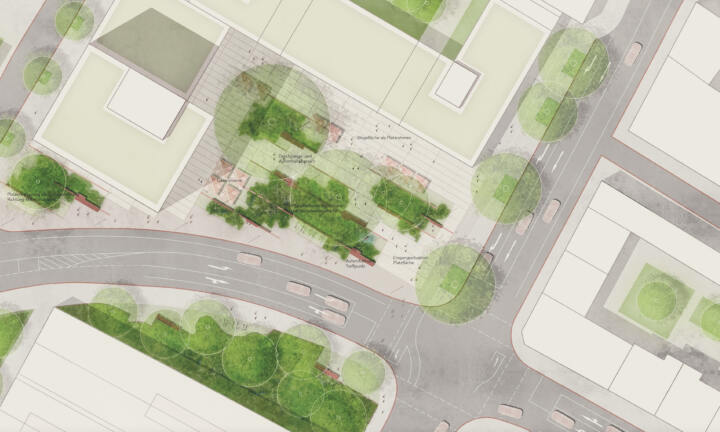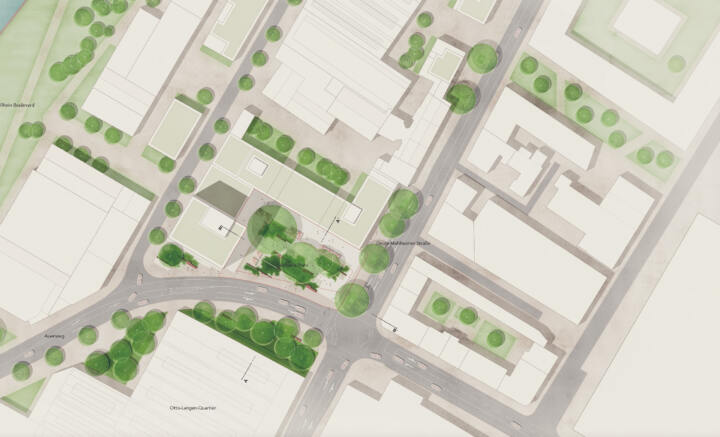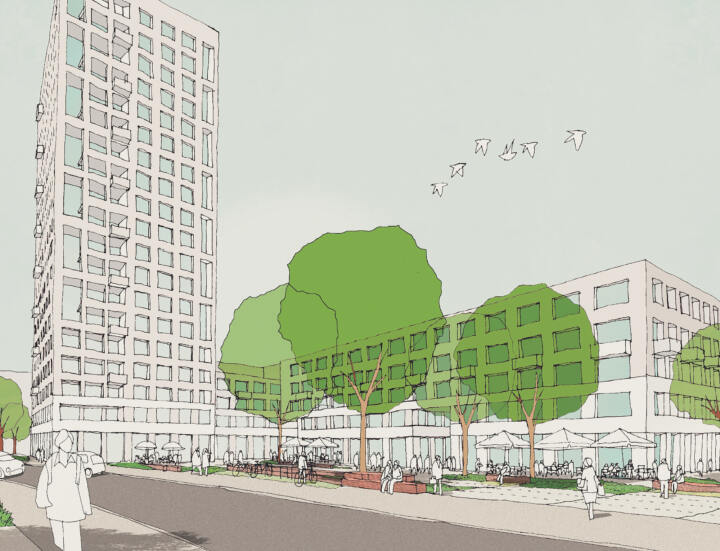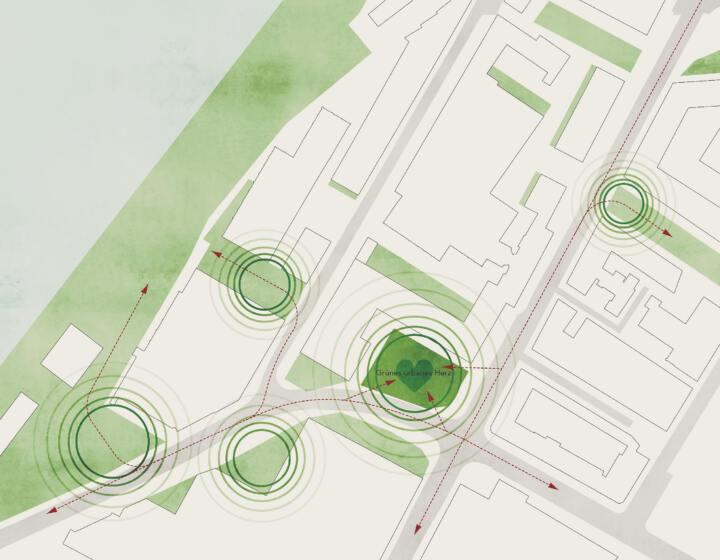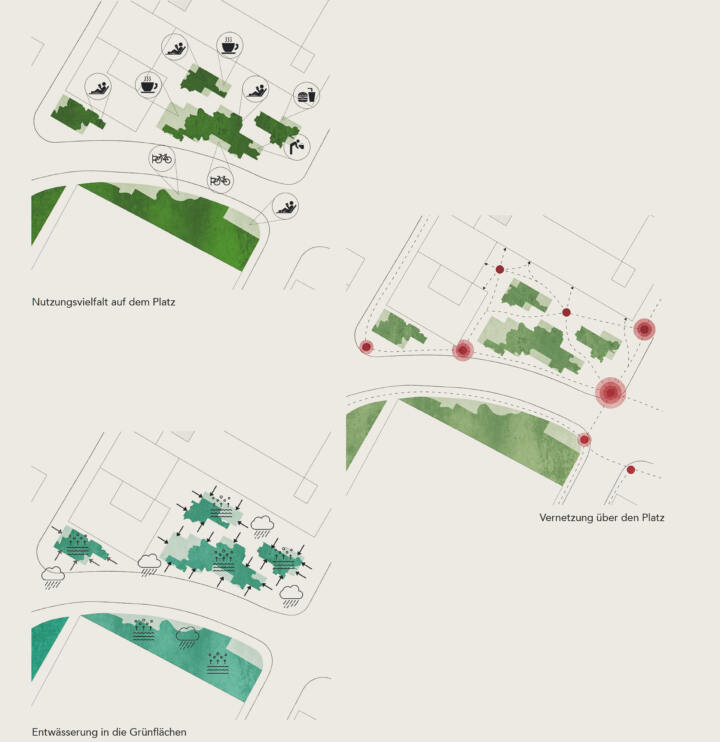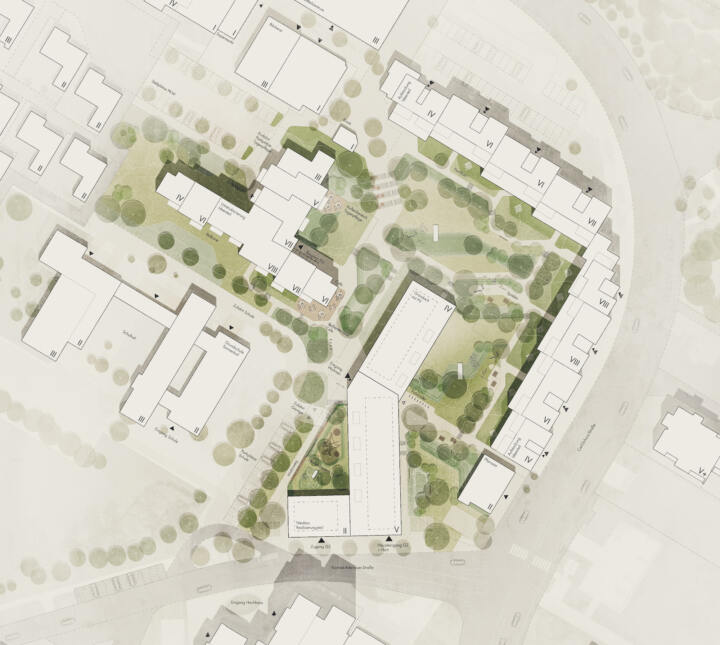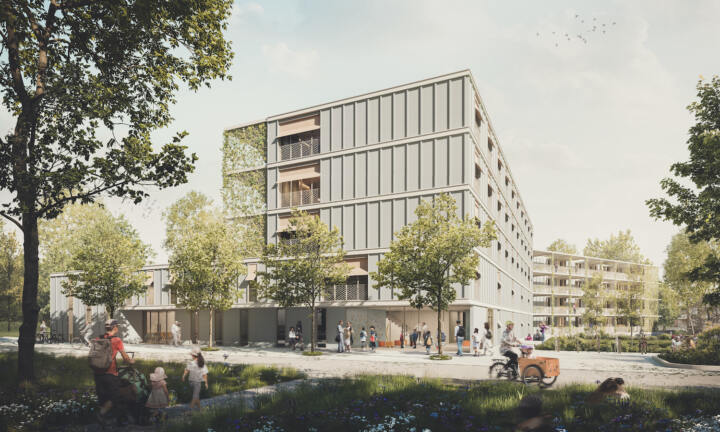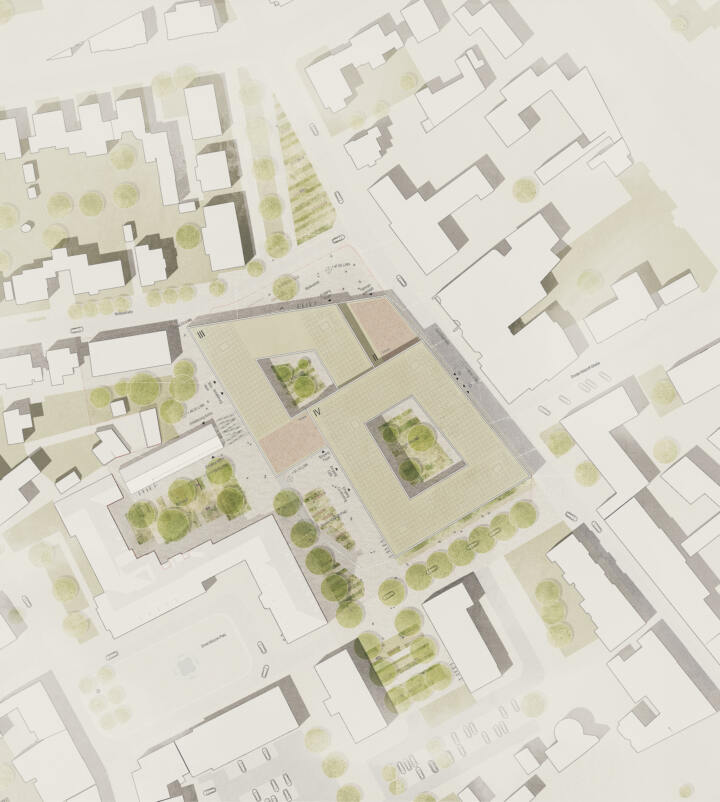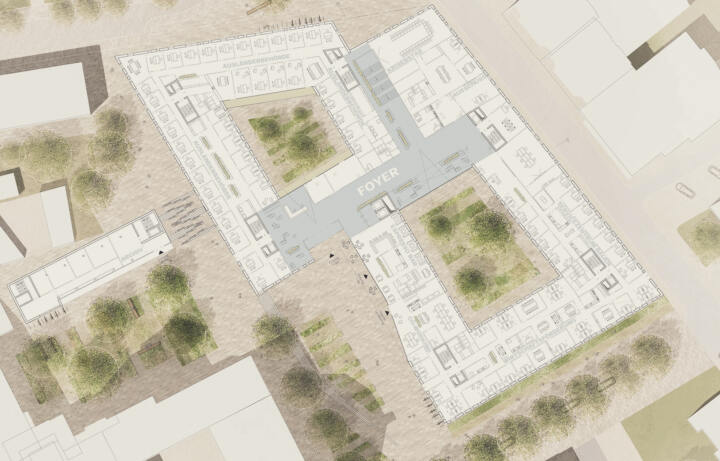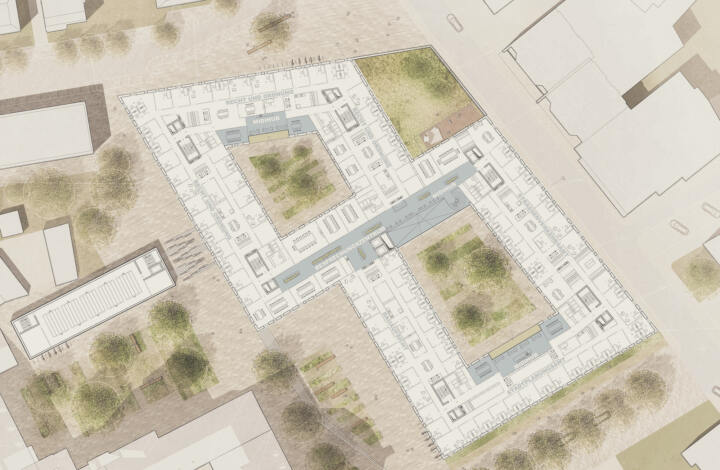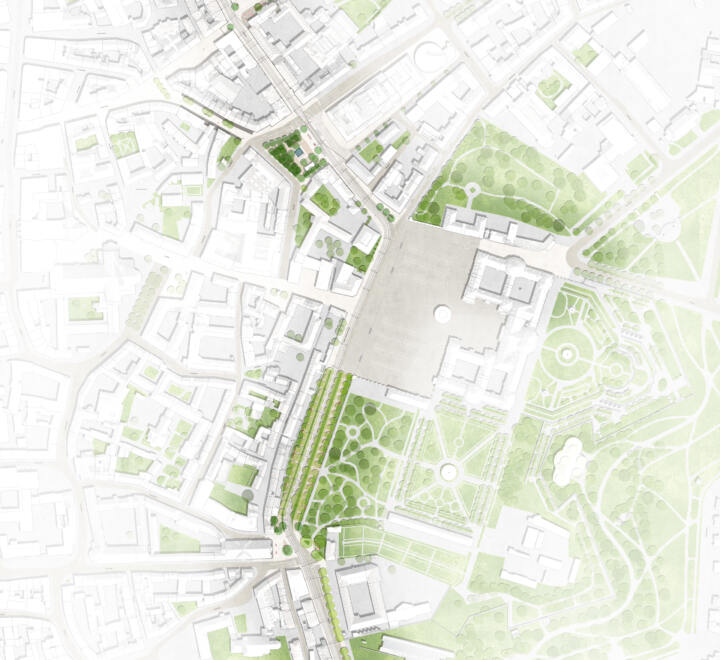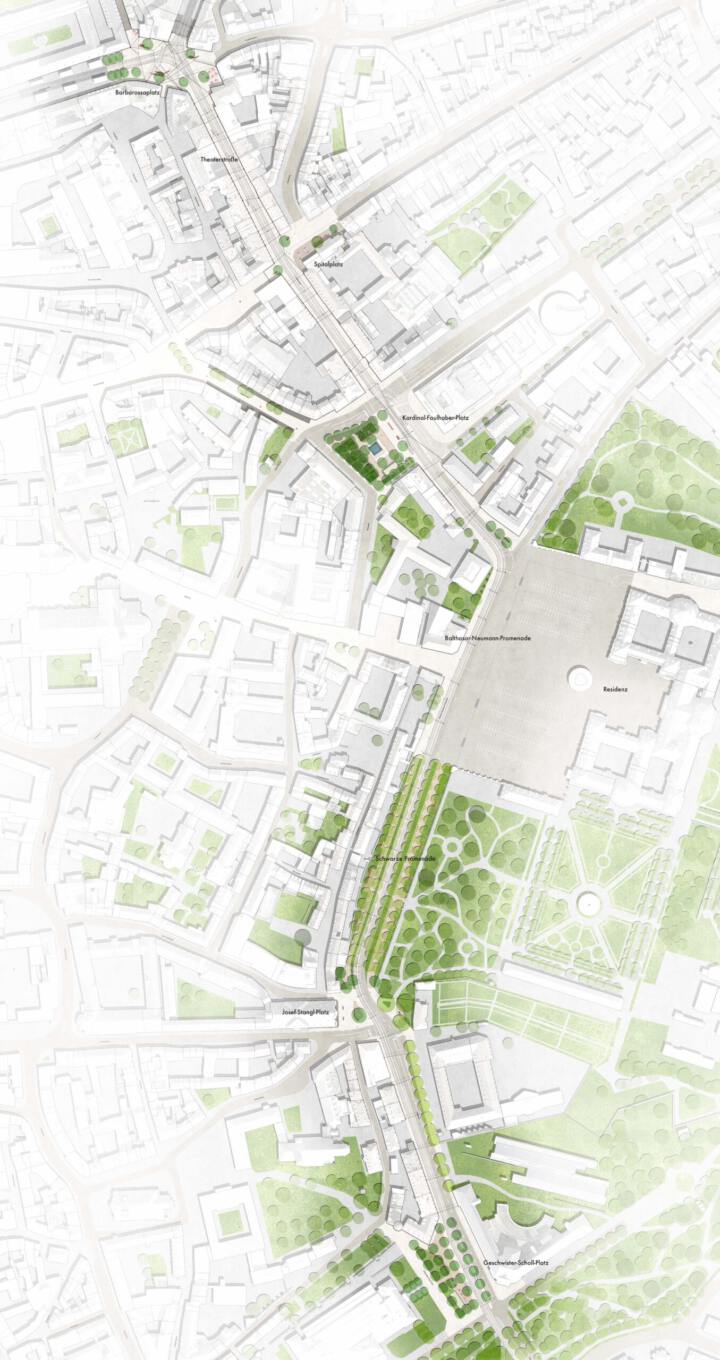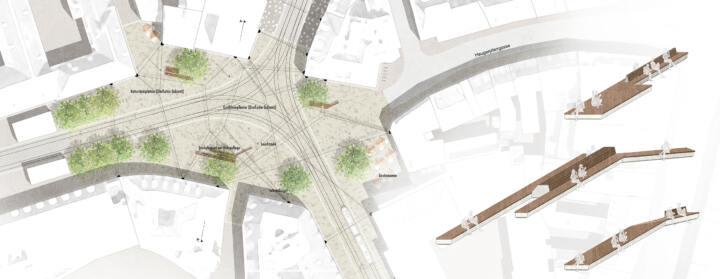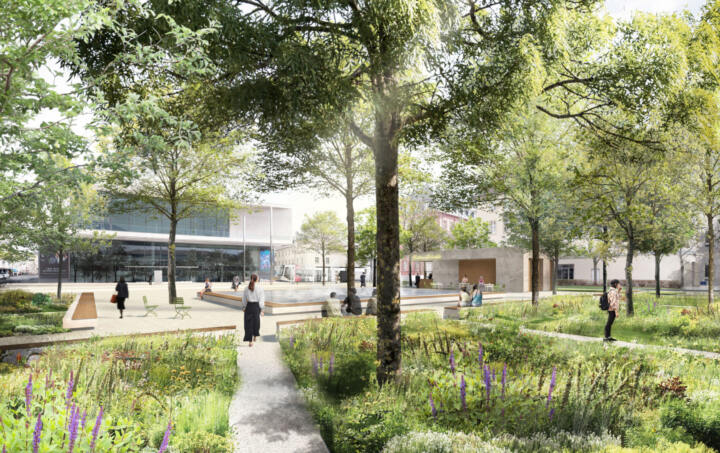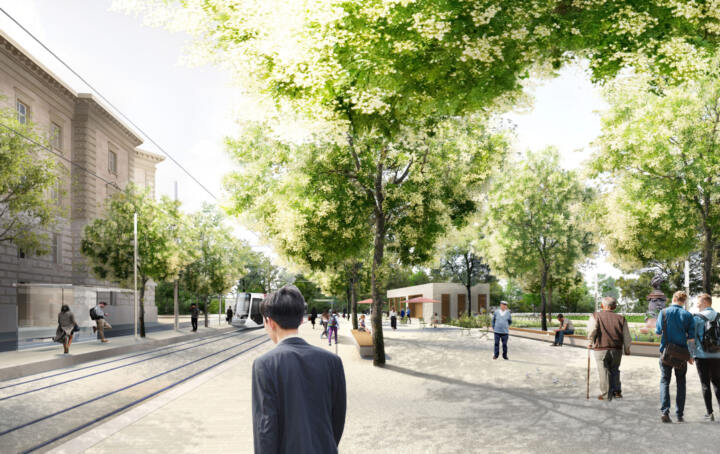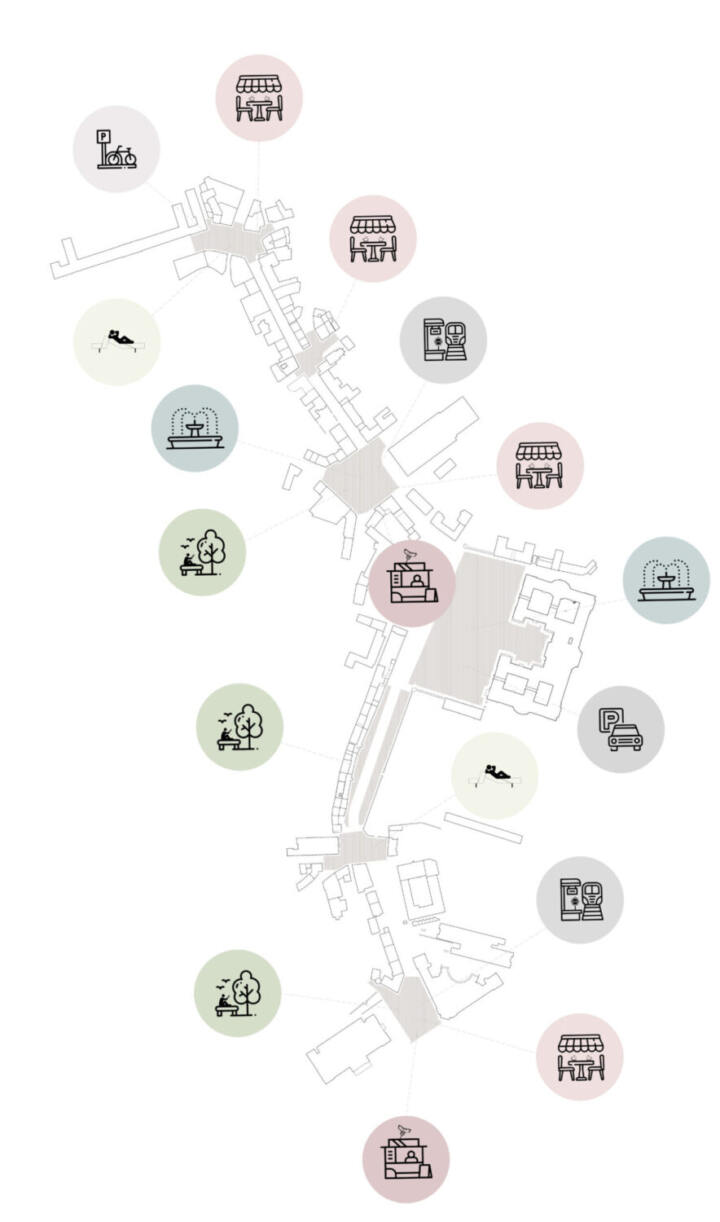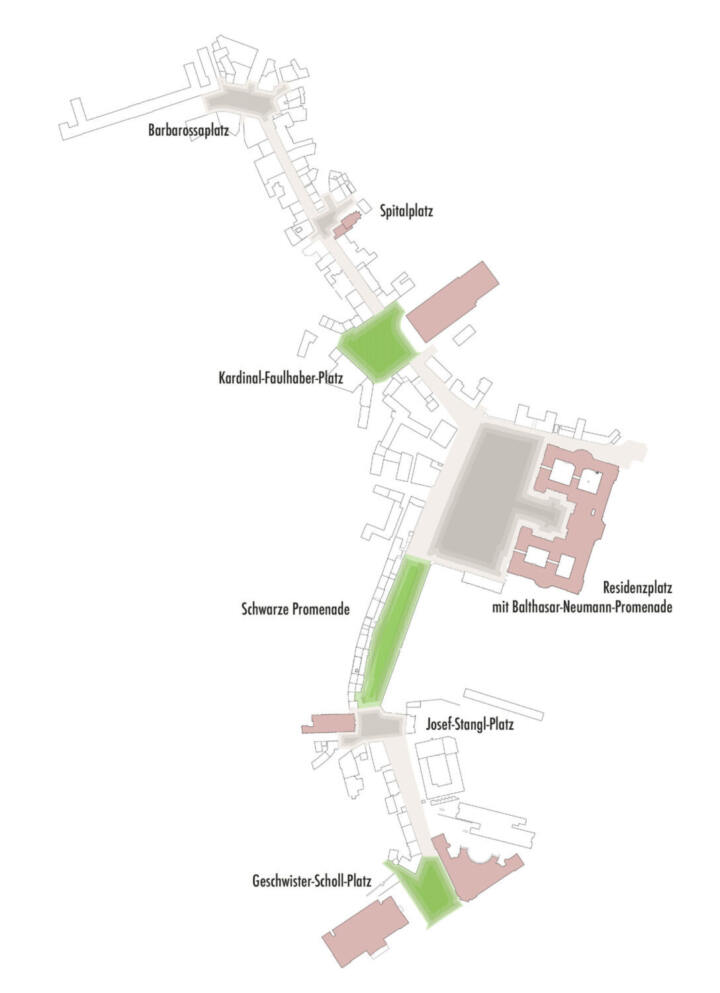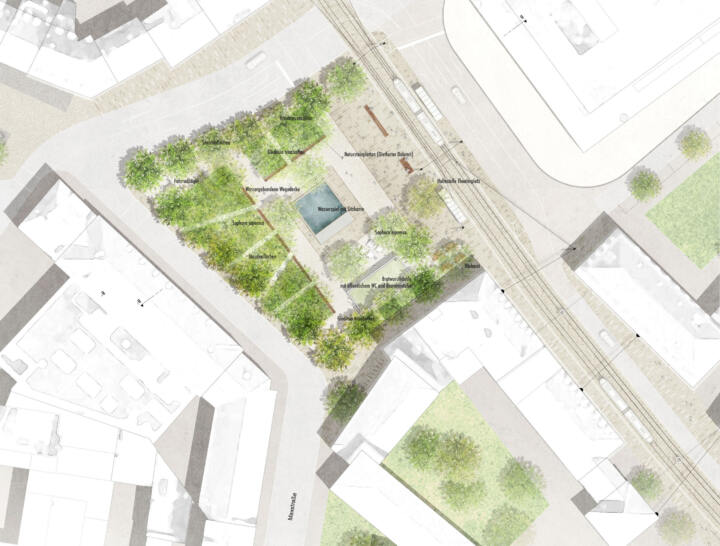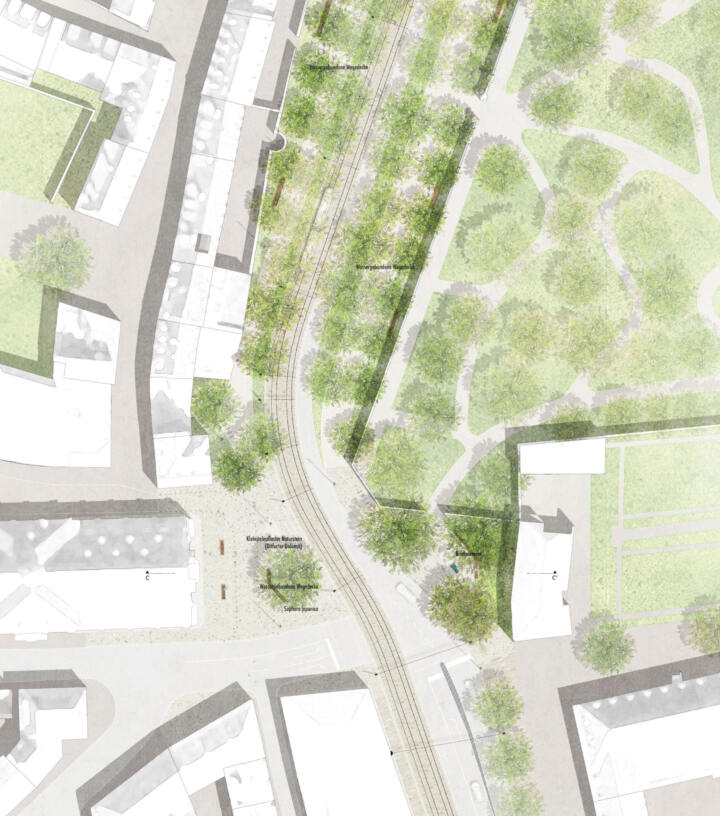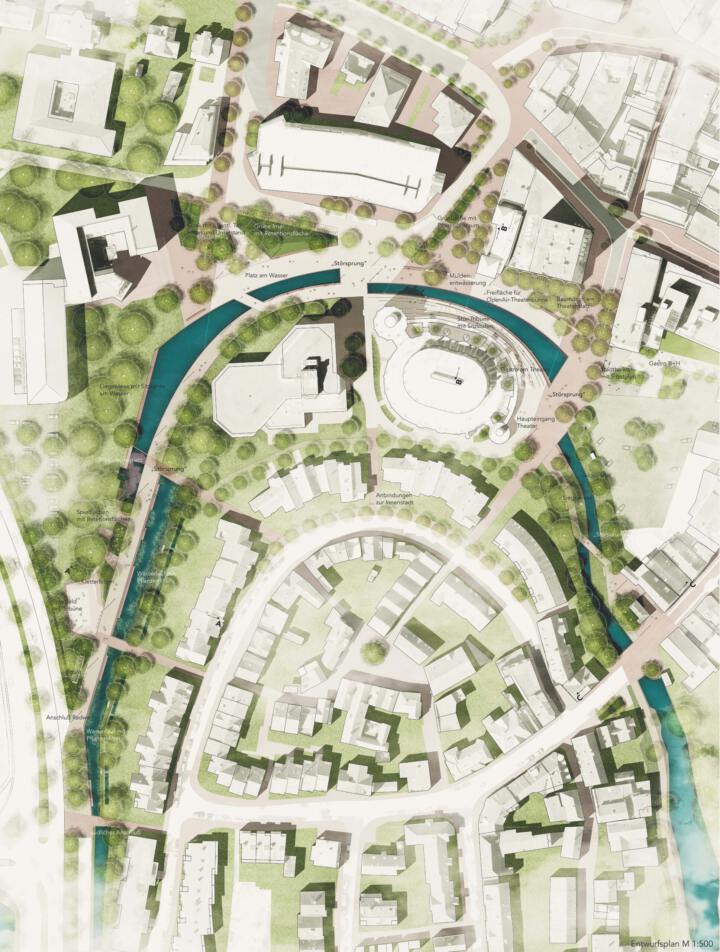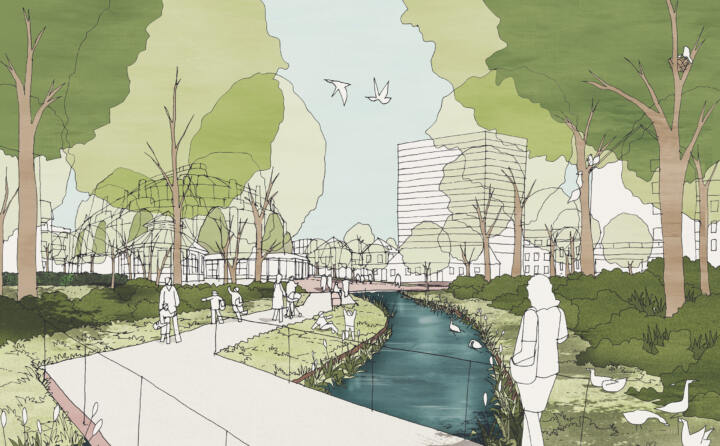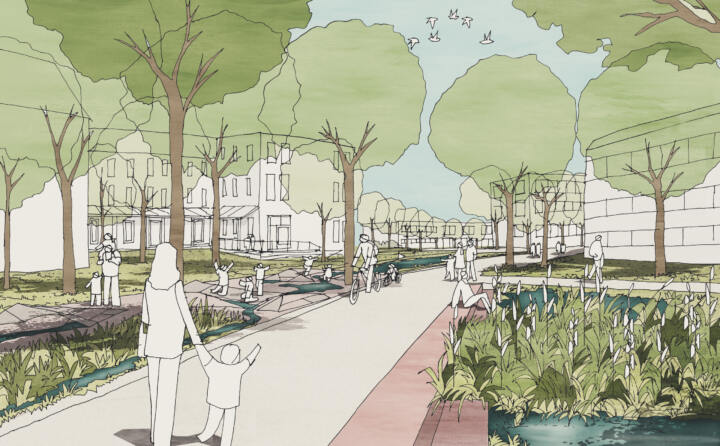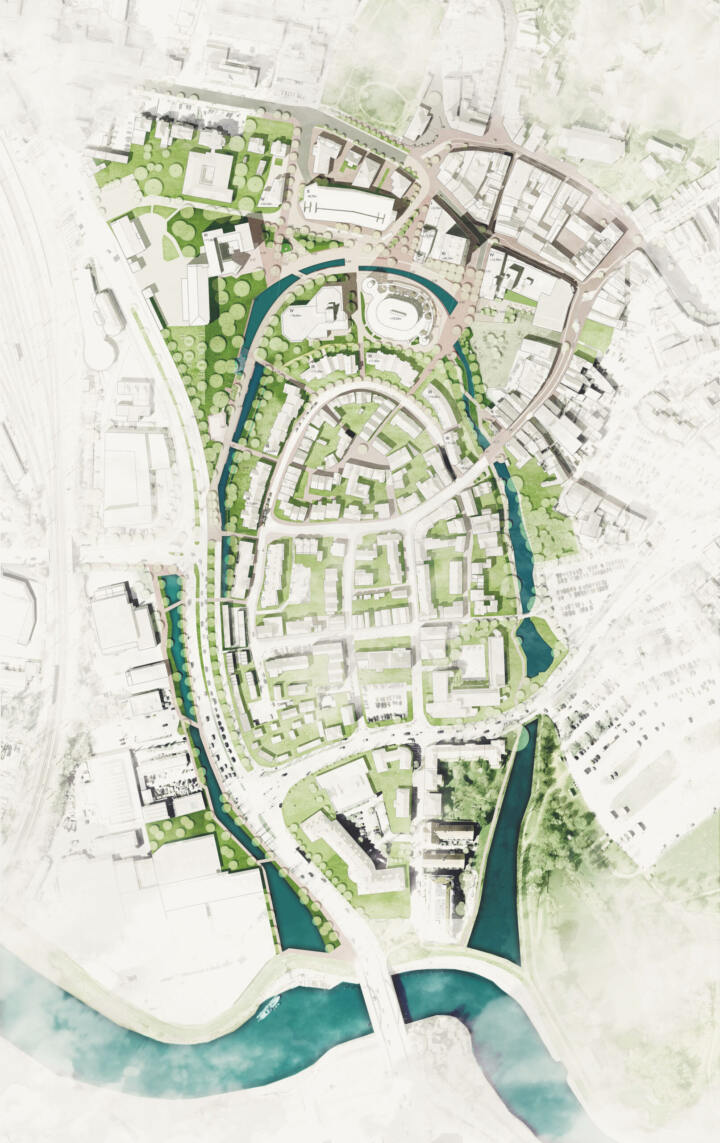Vocational Training Center | Bamberg
2. Prize | Vocational Training Center
Bamberg
In collaboration with Atelier 30
On the one hand, the urban planning idea is to position the new building for the education center along Forchheimer Straße in such a way that a clear address with a corresponding gesture is created here. On the other hand, the further course of the competition property is characterized by an exciting open space, in which some green structures with a biotope character are also present. The question arose here as to how the structure of the educational center develops between a clear urban development position, clever development, well-functioning workshops and internal processes towards the landscape.
The new building expresses its address along Forchheimer Straße through a representative three-story front building built alongside the street in wooden construction, which is followed by a forecourt situation with a recessed main entrance. On the one hand, the three-story front building is positioned symbolically along the street space, and on the other hand, the forecourt creates a very nice address when you arrive from Bamberg city center. All ancillary rooms and storage areas are functionally adjacent to the workshops. Easily usable courtyard situations are developing between the workshops. These “workyard areas” open up to open space and create exciting spaces and zoning between the different training facilities. The shape of the entire ensemble is essentially characterized by sustainable wooden construction with larch formwork.
The heart of the education center is the central access and communication corridor with two green inner courtyards from which the individual workshops are accessible. The cafeteria with terrace area, the shared self-study area and the theory room are also centrally located here. Appropriate gate systems mean that forklifts can be driven across the factory yards and larger workpieces can enter the halls. If you look at the entire structure of the concept for the education center, you will notice, in addition to well-functioning processes, exciting visual and interior connections between the workshops, inner courtyards, glazed corridors and learning areas and the cafeteria. The proposed spatial sequence creates a highly attractive and diversely usable educational landscape, with open communication zones where it is fun to work and learn.
The outdoor facilities of the vocational training center are characterized by a well-thought-out and attractive design that takes both functional and aesthetic aspects into account. The spacious forecourt, which forms a contrast to the concrete block area with an inlay of grass paving stones, invites you to linger and offers numerous seating options that are embedded in the surrounding slabs. This creates a harmonious connection between urban design and natural surroundings and forms an important contribution to the trees’ rainwater concept. The bicycle parking spaces are also laid out on grass pavers, allowing rainwater to seep away. This allows drainage to be optimized and a spacious green area to be created that offers space for numerous trees.
Small green courtyards provide additional green oases in the outdoor area of the education center. Here, learners can enjoy a natural environment and spend time in a relaxed atmosphere. In addition, a spacious terrace area was created that can be used multifunctionally.
Here there is not only space for learning and working, but also for eating and relaxing. Particular attention was paid to creating only the minimum amount of paved areas for deliveries and collections. This creates a large green zone that is not only aesthetically appealing, but also promotes ecological balance. The use of parking spaces made of grass grids with intermediate greenery creates further opportunities for integrating trees, which round off the overall appearance of the outdoor areas and create a harmonious connection to nature.
Astrid-Lindgren-Avenue | Cologne-Brück
1. Prize after Review | Astrid-Lindgren-Avenue
Cologne-Brück
In collaboration with hector3 architects
The area surrounding the planning area is characterised by heterogeneous structures. One to two-storey detached and terraced houses in open-plan construction form the residential areas here. To the east of the planning area, the landscaped conservation area along the Flehbach stream forms a green counterpart.
The urban planning overhaul opens up the opportunity to lay the foundations for high-quality neighbourhood development.
– with moderate and high-quality urban densification
– while at the same time minimising land sealing and
– the preservation of existing green spaces
– the creation of new private, communal and public open spaces
– as well as roof/façade greening and rainwater retention to optimise the local climatic situation,
– offer contemporary mobility
– to reduce motorised private transport to a minimum
– redesign the mix of diverse residential requirements and integrate them into the neighbourhood
The central mobility area will become a mixed traffic area. The adjacent car parking spaces above ground are only available to the residents of the single-family homes in order to keep the number of private cars in the neighbourhood to a minimum. Decentralised waste collection points and bicycle parking facilities at the entrances to the neighbourhood contribute to the creation of a low-car neighbourhood with short distances.
The following points are integrated into the planning for sustainable development:
– Preservation of existing trees in combination with targeted planting of new trees
– Creation of new private, communal and public open spaces
– Creation of rainwater retention in the form of retention troughs along the Oberer Bruchweg
– Greened and planted underground car park ceilings
– Green façades and roofs, combined with solar/PV systems
– Efficient building technology utilising renewable energy sources
– Networking and reducing traffic
Airy garden zones with path axes are planned, accompanied by a green infrastructure for binding CO2, cooling the city, fresh air, rainwater retention, infiltration during heavy rainfall and groundwater recharge.
The new residential quarter is characterised by the close networking of block interiors and exteriors. The spatial and functional interactions between the inner courtyards, the central square and the neighbouring urban spaces give individual house units a distinctive character, their own orientation and a high quality of stay. The result is a neighbourhood of short distances and clearly defined spaces.
A small “neighbourhood square” at the intersection of various paths and visual connections forms the centre of the quarter. The spatial constrictions at the square entrances indicate the neighbourhood-related character of the square. The quiet atmosphere of the landscaped courtyards at the sides contrasts with the more public character of the neighbourhood square and thus supports its central importance. The open structure of the neighbourhood also enables pedestrian connections to the nearby old and new neighbourhoods and green spaces. The natural play facilities in the residential courtyards strengthen social cohesion and turn the open spaces into lively meeting places. Permanently installed table-bench combinations under the pergolas and an initial range of areas for urban farming, which can be expanded if required, are also part of the project.
Lindgens-Areal | Cologne
2. Prize | Lindgens site
Cologne
A green urban heart for a new district
The square fronting the Lindgens site creates a new, high-quality urban open space at the gateway to the new district. With its lush, green planting areas and robustly paved paths and surfaces, the design aims to maintain an equilibrium between the minerality of an urban square and the greenery of a pocket park, while focusing on producing a high-quality welcoming environment that connects up with adjacent urban and green spaces. The square clearly delineates a distinct urban space, and consequently functions as a gateway to the new Lindgens site. In particular the design approach addresses and offers contemporary solutions to several topics such as creating an attractive environment, functional issues and climatic resilience, providing an unmistakably recognisable identity, networking and mobility issues, and the overall proportion of the area devoted to green space. This results in an ecologically sound and sustainable urban space with its own identity and function, where urban life can take centre-stage.
The square’s design language makes reference to the area’s historical industrial architecture, with its linear-patterned brick facades and regular arrangement of windows. This configuration serves as a precedent for the design of the square and is translated into the paving system in the form of a large-scale grid that spatially clearly defines the square and gives it a singular character. The design also incorporates the existing historic wall on the area’s south-western boundary, which is dismantled and reused in the form of wall panels and for furnishing the square. These wall and furnishing elements serve to structure the square and, depending on the vantage point, generate different spatial effects. Extensive, irregularly shaped areas of planting are arranged so as to incorporate the valuable existing trees on site, and they also help to define key pedestrian routes across the square. This, combined with the judicious placing of wall panels that intersect and delineate the planted areas, produces exciting vistas that exploit ideas such as transparency and demarcation, or foreground and background, and it alters how people perceive the square depending on where they are. The overall structure of the square creates an exterior and an interior space, and thereby areas with different atmospheres and diverse qualities. Areas fronting the new building are distinguished by a change in grid format and are mostly kept free as paths and for outdoor catering. They also provide a mineral contrast to the intensively landscaped centre of the square.
Themes of sustainability and ecology are reflected in how the planted areas are designed and how they function as water retention areas or water infiltration areas. Once the existing polluted soil in areas designated for future planting has been replaced, all the rainwater accumulating on the square will be channelled off into the planted areas, where it can evaporate and seep away. The aim is to create a good microclimate over the entire square plus the areas that border onto it, and thus to avert heat islands in urban space. The planted areas, in addition to contributing to design quality, also offer a high degree of biodiversity and create new habitat for animals and insects. Surfaces are restricted to a limited palette of materials, with concrete block paving in areas with the footpaths running along the surrounding streets, grass-permeable modular paving adjacent to planted areas, and large-scale concrete slabs for the square itself. This results in an exciting contrast of different formats and surfaces that give the square a unique character and thus serve to reinforce its function as a gateway to the Lindgens site.
The design aims to generate a contemporary urban square that reflects how the new site will be used in the future, yet at the same time refers to its historical use. The idea is to strike a balance between the area’s industrial past and future use, and in doing so, create a new identity for the district.
Sonnenhof | Pforzheim
Recognition | Sonnenhof
Pforzheim
In collaboration with schneider+schumacher
The concept aims to preserve the special quality of the site and to reconnect already existing functions, spatial and pathway relationships. The added row building creates a spatial reorganisation: it forms a pivotal point that spans its public functions with the community centre and after-school care centre in the south, opens the triangular outdoor space of the after-school care centre to the school, and arranges a residential use above it that is oriented alternately to the existing green spaces. The adjacent residential development of the idea section undergoes both a restructuring and a cautious expansion. These measures respect and strengthen the existing qualities of the site and create new outdoor space references.
School nursery
The group rooms of the after-school care centre are arranged on top of each other on two floors and open up with their façade to the open space of the after-school care centre. Small group rooms and group rooms each form a flexible unit that can be joined together. The transition between indoors and outdoors takes place via a roofed intermediate zone that provides both weather protection and shade. The outdoor area of the after-school care centre is spatially oriented in such a way that the existing green inner courtyard is protected from the noise emissions of the after-school care centre during the day. Due to its orientation to the west, it is functionally related to the neighbouring Sonnenhof School.
Community centre
The community centre is the meeting place for the residents of the estate. The hall next to the small foyer, which allows separate access independent of the after-school care centre, has a double room height, which allows the structural integration of the historic church window in a prominent position. Due to the close spatial connection, the community hall can also be used by the after-school care centre and is also available for other public uses.
Housing
The new residential block will contain 51 residential units that are eligible for social subsidies. While the address is formed in the west via the central foyer, the internal development takes place via an open arcade system, which is arranged alternately along the length of the building and thus creates different qualities for the flats. The arcades are extra-wide and have air spaces that serve both to provide light and to create increased privacy for the adjoining rooms. The open spaces are located in the area of the entrance zones and can contribute to communication among the residents as open meeting and lounge zones. The open spaces are delimited by plantings that green and enliven the pergola zone.
Town Hall extension at Droste-Hülshoff-Platz | Bottrop
Recognition | Town Hall Extension at Droste-Hülshoff-Platz
Bottrop
In cooperation with Lepel & Lepel
The landscaping concept for the Town Hall extension displays clear-cut linearity and employs recurring elements and a long vista to connect the Town Hall with the inner city.
The proposed scheme envisages a variety of spaces, each with a different quality. In the north, a pocket park will create a central square, with bicycle parking and seating. Adjacent to this is the Town Hall garden, which can be accessed from the back of the new building via a staircase with an integrated ramp. The Town Hall garden is divided into sections by a planted area, with trees and raised beds as well as seating. Passing by the Town Hall garden, one reaches Droste-Hülshoff-Platz, which is subdivided by a flight of steps and a row of trees. Above, a space for lingering is created with loosely distributed seating, and incorporates an outdoor café, and the staircase steps provide a place for people to sit. The lower part of the square is designed as a wide traffic-accessible thoroughfare that extends the visual axis to the city centre.
The building’s inner courtyards evoke a jungle-like atmosphere with their generously planted vegetation of varying heights.
The landscaping concept uses various measures to address climate change and also contributes to improving the city’s climate. Trees provide shade, while light coloured surfaces are designed to help mitigate warming. Furthermore, low-maintenance flowering beds, shrubs and lawns as well as large joints and lawn paving sets allow water first to seep away, then be stored, and finally evaporate. Excess water is temporarily stored using infiltration systems. The roofscape also contributes to evaporation through being intensively planted, and in addition roofs are equipped with photovoltaic panels.
Open space and square design for the new streetcar line Hubland district | Würzburg
3x 2. Prize + 1x 3. Prize | Open space and square design for the new tram line in the Hubland district
Würzburg
In collaboration with Benkert Schäfer Architekten
The new tram line to the new Hubland district runs through the city centre and, with the opportunity to redesign the space running alongside it, will create a greatly enhanced quality of open space for the city of Würzburg. The redeveloped traffic infrastructure and traffic organisation in the city centre resulting from this new intervention will also allow existing urban spaces to be reconfigured: the redesign will address former deficits in terms of their ambience and function, climatic resilience, identity and perception, how spaces connect, plus mobility issues and the amount of green space. Depending on the urban context of each one, these spaces will be transformed in a contemporary and sustainable way by providing new functions and enhancing the urban environment. The design aims to create a multitude of uses through connecting a network of open spaces into the adjacent existing urban fabric, while safeguarding green spaces and ensuring an ecologically sustainable approach to urban space.
Large trees will be planted in places that are suitable in terms of concept and character, whereby the extent of new planting will always take account of the planned use and the appearance of each space. In this way, an appropriate balance of “hard”, stony space and “soft”, green urban space will be created along the new tram line.
Barbarossaplatz – an important urban link between Kaiserstrasse, Juliuspromenade and Theaterstrasse – will be redesigned as a triangle of tracks, thereby unting its two functions as both traffic junction and pedestrian zone. The square, which is extensively enclosed in terms of urban development, opens up important vistas to the surrounding urban space, and these will be further strengthened in the redesign. The redesign integrates existing trees and these will then form a framework for supplemental planting. Large multifunctional seating elements are arranged in the three surrounding areas, corresponding to the vistas. The resulting square has an attractive ambience and thus serves as a meeting point in the city centre, as well as providing orientation for the surrounding urban spaces. The orientation of the uniform natural stone slab paving takes its cue from the adjacent street spaces and their surfaces.
Kardinal-Faulhaber-Platz
Kardinal-Faulhaber-Platz will be enlarged in the course of the redesign and will then be of an appropriate size to function as an important urban space. Spatially, it is oriented towards the new tram stop and the theatre. A new frame of trees and planted areas will open it up towards the theatre and separate it from the surrounding traffic areas. The trees will be planted in the adjacent green spaces and in the water-bound path surface that frames the middle of the square, with its large water feature clearly defining the centre, with seating around the edge.
The paving of the square consists of large-format natural stone slabs, water-bound pavement and green areas. The dimensions of the square will extend to such an extent, that it clearly refers to the theatre. The “Bratwursthäusle” kiosk is a rectangular structure whose design is derived from the square and the theatre. Green areas are planted with perennials and serve as retention areas. Rainwater that is retained on the square is either fed underground to the trees, seeps away, or evaporates, creating a green city square with park-like character that offers visitors a cooling microclimate in the hot summer months.
Josef-Stangl-Platz
The surface area of Josef-Stangel-Platz will also be extended by reducing the adjacent trafficked areas. On one hand, the church of St. Michael is thus given an appropriate forecourt and a new atmosphere; on the other, the square extends across the streets and includes the areas that border the courtyard garden, thus creating an entrée to it. On the square in front of St. Michael’s, a solitary tree in combination with a large seating element creates a shady place to sit, with the clear aim of integrating the church into the urban space, rather than eclipsing it. The large existing trees in the courtyard garden area will be retained and are embedded in planted areas, to ensure the theme of the courtyard garden is continued into the urban space, thus removing the existing clear-cut separation of the two.
Access to Domerschulstrasse via the square is subordinate to pedestrian and bicycle traffic and is zoned by means of suitably arranged bench elements, organised in such a way that traffic is clearly directed. Areas of water-bound pavement mark the recreational areas on the square, and the forecourt surface consists of a small paving-stones, providing a suitable framework for the significance of the church and alluding to its history.
Geschwister-Scholl-Platz
The location of Geschwister-Scholl-Platz, between the district court, the university building and Ringpark, has an urban significance that will be further enhanced with the new tram line and the associated tram stop.
The traffic areas are being redesigned to allow the square to be further expanded and its quality to be improved. In order to make the square clearly recognisable, a gridded grove of trees is planned across the entire area of the space to link up with the Ringpark. The basic structure is formed by water-bound path surfaces, and planted areas which are oriented towards the university building, continuing the existing spatial structure.
The café “Brotzeitstube” on the square adds to the ambience and the square’s frequency of use, which is further helped by seating elements beside the planting, thus turning the square into meeting place. Following the redesign, Geschwister-Scholl-Platz will play an important role in the urban context, as it serves both as a link between the adjacent spaces and as an entrance to the Ringpark, thereby creating an important local landmark.
New Störschleife | Itzehoe
2. Prize | Neue Störschleife
Itzehoe
In collaboration with Heidt + Peters mbH
‘The Stör is jumping’
Close to the main square in Itzehoe, a new and high-quality open space will be created where people can experience both the ‘Neue Störschleife’ (a new loop in the river Stör) and the waters of the Stör river more tangibly than in the past. Essentially the ‘Neue Störschleife’ continues to follow its previous course however, through introducing an offset, it has been possible to introduce a new space including several water features, and various sub-areas plus multi-functional uses. The central space, north of the AOK building and the theatre, has a special significance as it is one of the few large, open squares in the city centre. This entire area will be designed as barrier-free accessible and it will have a distinctive quality through the introduction of arched benches, plus a variety of places to stop and relax overlooking the water. It also offers plenty of space for events, festivals and performances, or an open-air market, all of which can be experienced from the large staircase and steps with seating, located to the north of the theatre. The clinker pavement has been designed to link in with the adjacent shopping street.
In addition to the central square, various sub-areas have been created along the ‘Störschleife’. In the west, at the start of the watercourse, there is large-scale constructed wetland that resembles a natural water surface, and its seating steps invite visitors to linger. On the east side of the watercourse there are private spaces, allowing owners direct private access to the water. Along the watercourse, meadows and areas for play and sports activities invite visitors to linger too. One distinctive feature is the water playground area, allowing people to come into direct contact with water. Following the watercourse further to the east, a more natural picture emerges. The lushly planted flattened banks offer valuable shelter for animals.
In addition, a wide path for cyclists and pedestrians runs along the near-natural watercourse, linking up the various areas.
Sustainability
Another focus of the design is to ensure the scheme is sustainable. The scheme uses only shrubs and plants that have proved resistant to urban climates, and the overall aim is to have a high diversity of species. This high biodiversity is achieved not only through different tree species, but also through a mix of perennials and shrubs. These provide food sources and nesting opportunities for birds and insects, especially in the less frequented areas.
The choice of materials for the furniture was based on the design manual and only FSC-certified wood is being used. Existing natural stone will be reused and the clinker surfaces are all constructed using existing clinker material. In addition, the open space has numerous bicycle racks and efficient lighting is employed throughout.
Water cycle
The complete water cycle concept has been devised so that it contributes to increasing urban resilience. At the beginning of dry phases, for example, water levels in the system can be raised to positively influence evaporation in favour of the microclimate. If heavy rainfall is predicted, the water levels can be lowered in advance in order to exploit the retention capacity of the system.

